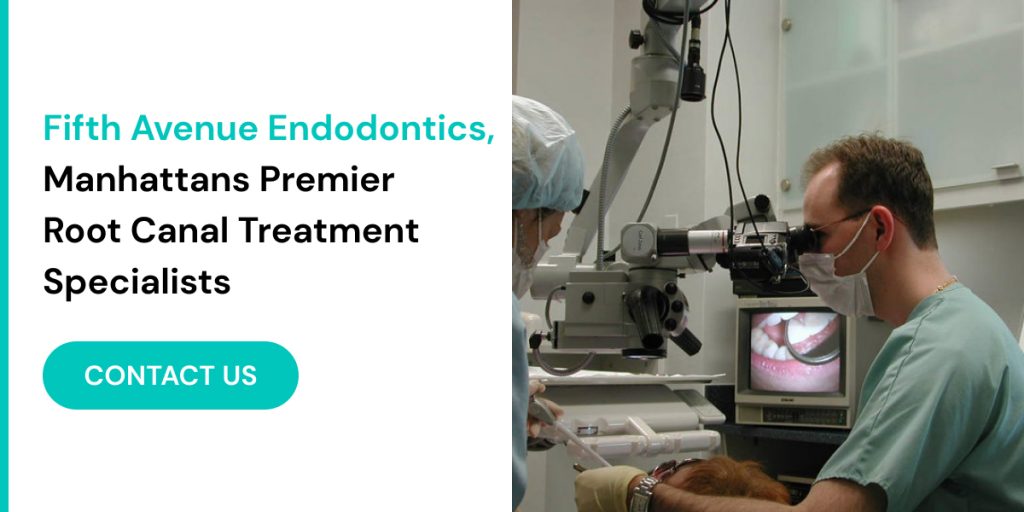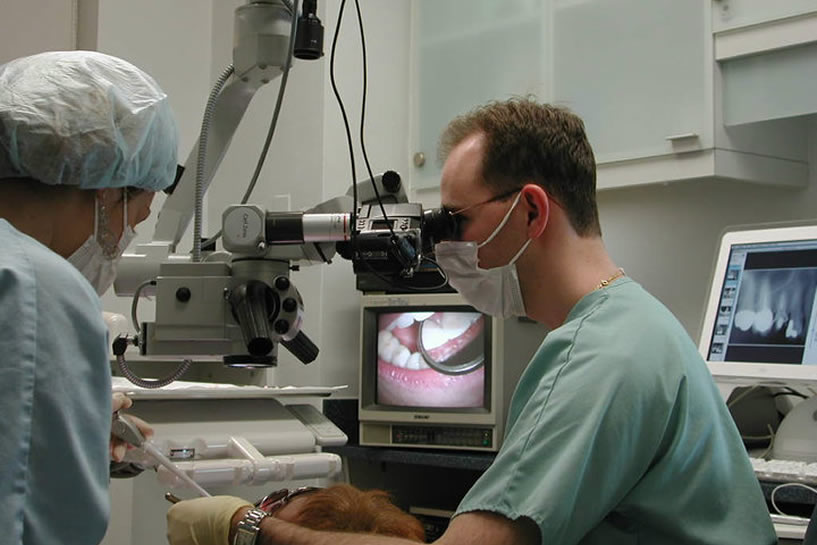Cracked teeth can be a source of significant discomfort and anxiety for many patients, often causing sharp pain and sensitivity that disrupt daily life. Understanding the role of endodontic therapy in cracked tooth treatment in New York can be crucial for anyone experiencing these symptoms. Cracks in teeth can vary greatly, from minor surface cracks that are mainly cosmetic to deeper fractures that threaten the integrity of the tooth and require immediate professional attention. This blog post will delve into the different types of tooth cracks, the symptoms associated with them, and how endodontic therapy, especially as practiced by experienced professionals like Dr. Iofin at Fifth Avenue Endodontics, plays a vital role in treating these dental issues.
Endodontic therapy, commonly known as root canal treatment, is often the best solution for saving a tooth that has a significant crack extending into the pulp. This treatment not only alleviates pain and removes infection but also preserves the natural tooth, preventing the need for extraction. Dr. Iofin’s expertise in handling such cases ensures that patients receive the highest quality care, tailored to their specific dental needs. By understanding the process and benefits of endodontic therapy, patients can approach their treatment with greater confidence and peace of mind.
Understanding Cracked Teeth
Cracked teeth can manifest in various forms, each requiring a different approach to treatment. Recognizing the type of crack is essential for determining the appropriate intervention. Here, we’ll explore the common types of tooth cracks, their characteristics, and the necessary treatments.
Craze Lines
Craze lines are small, superficial cracks that appear on the outer enamel of the tooth. These lines are often caused by normal wear and tear, and they can be seen in almost all adult teeth. Craze lines are typically harmless and do not cause pain or discomfort. They do not penetrate the deeper layers of the tooth and usually do not require treatment. However, they can sometimes be aesthetically displeasing. If their appearance bothers you, a cosmetic dental procedure, such as teeth whitening or bonding, can help to minimize their visibility.
Fractured Cusp
A fractured cusp occurs when a piece of the chewing surface of the tooth breaks off, often around a filling. This type of crack usually does not extend to the pulp, meaning it rarely causes severe pain. However, it can make the tooth more vulnerable to decay and other issues if not treated. Treatment for a fractured cusp typically involves removing the broken piece and restoring the tooth with a crown or filling to prevent further damage and restore its functionality.
Cracked Tooth
A cracked tooth is a more serious condition where a crack extends from the chewing surface toward the root. The crack may run vertically, and its depth can vary. If the crack affects the pulp, the tooth may experience significant pain, especially when chewing or when the tooth is exposed to extreme temperatures. Treatment depends on the extent of the crack. In some cases, a crown can hold the tooth together and prevent the crack from spreading. If the crack extends into the pulp, root canal treatment may be necessary to remove the damaged pulp and seal the tooth. It’s crucial to address a cracked tooth promptly to prevent it from progressing into a split tooth.

Split Tooth
When a cracked tooth remains untreated, it can progress to a split tooth. This occurs when the crack extends from the surface down to the root, effectively dividing the tooth into two distinct segments. A split tooth is often the result of severe trauma or prolonged, untreated cracking. Treatment for a split tooth typically involves endodontic surgery or, in severe cases, extraction. If a portion of the tooth can be saved, it may be possible to restore it with a crown. However, in many instances, the damage is too extensive, and the tooth must be removed to prevent infection and further complications.
Vertical Root Fracture
Vertical root fractures are cracks that start at the root and extend towards the chewing surface. These cracks are often more difficult to detect because they may not be visible without imaging and often do not cause symptoms until they become severe. When symptoms do appear, they often include pain, swelling, and infection in the surrounding bone and gum. Vertical root fractures can be particularly challenging to treat because they often indicate significant structural damage to the tooth. Treatment options may include endodontic surgery to remove the fractured root or, in severe cases, extraction of the tooth.
Understanding the different types of cracked teeth is vital for seeking appropriate treatment. At Fifth Avenue Endodontics, Dr. Iofin and his team are experienced in diagnosing and treating various forms of cracked teeth, offering specialized care tailored to each patient’s unique needs. Whether dealing with a minor craze line or a severe vertical root fracture, professional assessment and timely intervention can make a significant difference in preserving dental health and preventing further complications. If you suspect you have a cracked tooth, don’t hesitate to consult with experts who can provide the necessary treatment to restore your oral health.
Symptoms of Cracked Teeth
Symptoms of cracked teeth can vary widely, making diagnosis challenging for both patients and dental professionals. The symptoms often depend on the type, location, and extent of the crack. Here are some common signs to watch out for:
- Pain when Chewing or Biting: One of the most indicative symptoms of a cracked tooth is sharp pain when chewing or biting, particularly when releasing the bite. This pain occurs because the pressure on the crack can cause the pieces of the tooth to move, irritating the pulp and nerves inside.
- Sensitivity to Temperature Changes: Cracked teeth can cause heightened sensitivity to temperature changes, especially to cold. This sensitivity occurs because the crack allows hot or cold substances to reach the inner part of the tooth more easily, affecting the nerve endings.
- Intermittent Pain: Pain from a cracked tooth may not be constant. Instead, it can come and go, making it difficult to pinpoint the exact cause. The pain might occur spontaneously or in response to certain actions, like eating specific foods or changing temperatures.
- Swelling of the Gum: In some cases, the gum around the affected tooth may swell. This swelling is often a sign of inflammation or infection resulting from the crack allowing bacteria to enter the tooth’s inner structures.
- Difficulty Identifying the Painful Tooth: It’s not uncommon for patients to have difficulty identifying which tooth is causing the pain. Cracked teeth can radiate pain to adjacent teeth or even to other parts of the mouth, complicating the diagnosis.
If you experience any of these symptoms, it’s essential to seek professional dental advice promptly. Ignoring these signs can lead to more severe issues, such as infection, abscess formation, or the need for more extensive dental treatments. At Fifth Avenue Endodontics, Dr. Iofin and his team are well-equipped to diagnose and treat cracked teeth. They use advanced diagnostic tools and techniques to identify the exact location and extent of the crack, ensuring appropriate and timely treatment to prevent further complications and preserve your oral health. Their expertise in managing cracked teeth can alleviate your symptoms and restore the functionality and aesthetics of your tooth, allowing you to return to your daily activities without discomfort.
Diagnosis of Cracked Teeth
Diagnosing a cracked tooth treatment requires a thorough and meticulous examination by a dental professional. Due to the often subtle nature of cracks, multiple diagnostic methods are employed to ensure an accurate diagnosis. Here are some key techniques used in identifying cracked teeth:
- Visual Examination: The first step in diagnosing a cracked tooth is a comprehensive visual examination. Dentists use magnification tools and bright lighting to inspect the tooth’s surface closely. Tiny cracks, such as craze lines, can be visible to the naked eye, but deeper or more severe cracks might require more advanced visualization techniques.
- Probing: Dental instruments, such as explorers, are used to probe the tooth surface and detect cracks or sensitive areas. By gently running the instrument along the tooth, the dentist can identify any irregularities or areas of pain that indicate a crack. Probing helps in determining the depth and direction of the crack, crucial for planning the appropriate treatment.
- Bite Tests: During a bite test, the patient is asked to bite down on a special instrument or material. This process helps to locate the crack by isolating the pain to a specific area. The bite test is particularly useful for identifying cracks that cause pain upon releasing the bite, a common symptom of cracked teeth.
- X-rays: Although cracks in teeth often don’t show up on X-rays, these imaging tools are still valuable in the diagnostic process. X-rays can reveal other issues caused by the crack, such as bone loss, pulp damage, or infections. They provide a comprehensive view of the tooth’s internal structures, helping to rule out other potential problems.
- Transillumination: This technique involves shining a bright light through the tooth. Healthy tooth enamel allows light to pass through uniformly, but cracks disrupt this pattern, making them visible. Transillumination is particularly effective in detecting vertical root fractures and other types of cracks that are difficult to see with the naked eye.
- 3D Imaging and Cone Beam CT Scans: In some cases, advanced imaging techniques like 3D imaging or cone beam CT scans are used. These technologies provide detailed images of the tooth and surrounding structures, allowing for a more precise diagnosis. They can help detect fractures and assess the extent of damage in complex cases.
Diagnosing a cracked tooth accurately is essential for effective treatment. At Fifth Avenue Endodontics, Dr. Iofin and his team utilize these advanced diagnostic tools and techniques to ensure a comprehensive evaluation. Their expertise and attention to detail help in identifying even the most subtle cracks, enabling timely and appropriate treatment. Accurate diagnosis not only alleviates pain and prevents further complications but also ensures that patients receive the best possible care for their dental health. If you suspect a cracked tooth, seeking prompt professional evaluation can make a significant difference in preserving your tooth and overall oral health.
The Role of Endodontic Therapy
Endodontic therapy, also known as root canal treatment, is a common and effective treatment for cracked teeth that have affected the pulp. This procedure involves:
- Removing the Infected Pulp: The damaged pulp is removed to prevent further infection and pain.
- Cleaning and Shaping the Root Canal: The empty canal is meticulously cleaned and shaped to remove all bacteria and debris.
- Filling the Root Canal: The cleaned canal is filled with a biocompatible material to seal it and prevent future infections.
- Restoring the Tooth: A crown is often placed on the treated tooth to restore its function and appearance.
Benefits of Endodontic Therapy
- Pain Relief: Endodontic therapy can alleviate the pain caused by a cracked tooth by removing the infected pulp.
- Preventing Infection: Cleaning and sealing the root canal prevents the spread of infection to surrounding tissues.
- Preserving the Tooth: Unlike extraction, endodontic therapy allows the patient to keep their natural tooth, maintaining their natural bite and appearance.

Case Study: Success Story from Fifth Avenue Endodontics
One of the many success stories at Fifth Avenue Endodontics involves a patient who came in with a severe cracked tooth. The patient experienced sharp pain when biting and had significant sensitivity to cold. Upon examination, Dr. Iofin diagnosed a deep crack extending into the pulp. Through precise and careful endodontic therapy, the infected pulp was removed, the root canal was cleaned and sealed, and a crown was placed to protect the tooth. The patient’s pain was alleviated, and the tooth was preserved, showcasing the effectiveness of endodontic treatment for cracked teeth.
Preventing Cracked Teeth
Prevention is always better than cure. Here are some tips to help prevent cracked teeth:
- Avoid Chewing Hard Objects: Refrain from chewing on ice, pens, or other hard objects that can crack teeth.
- Wear a Mouthguard: If you play contact sports or grind your teeth at night, a mouthguard can protect your teeth from cracks.
- Maintain Good Oral Hygiene: Regular brushing, flossing, and dental check-ups can help keep your teeth strong and healthy.
- Address Dental Issues Promptly: If you notice any signs of tooth damage, seek professional help immediately to prevent further complications.
When to Seek Professional Help
If you suspect you have a cracked tooth, it’s crucial to seek professional help as soon as possible. The earlier the diagnosis and treatment, the better the outcome. Dr. Iofin at Fifth Avenue Endodontics has extensive experience in diagnosing and treating cracked teeth, providing expert care tailored to each patient’s needs.
Conclusion
Cracked teeth can pose a significant threat to your oral health, but with the right diagnosis and treatment, their impact can be effectively managed. Endodontic therapy plays a crucial role in treating cracked teeth, offering pain relief, preventing infection, and preserving the natural tooth. For those seeking cracked tooth treatment in New York at a reputable practice like Fifth Avenue Endodontic ensures that you receive the highest standard of care. Under the expert guidance of Dr. Iofin, patients can achieve optimal dental health and maintain their natural smiles. If you are experiencing symptoms of a cracked tooth, don’t hesitate to seek professional help and explore the benefits of endodontic therapy.

